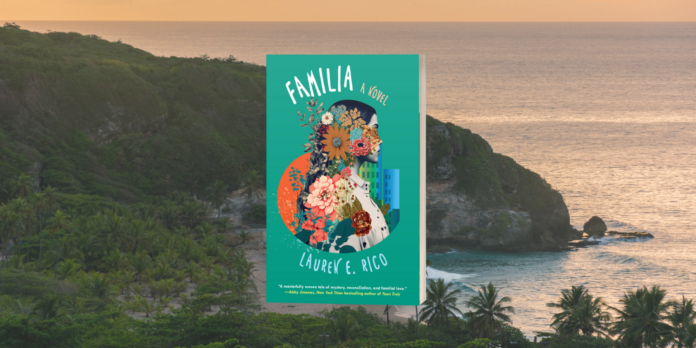If you’re lucky, at least once in your lifetime you will find yourself someplace where you feel free, where the detritus of everyday life falls away and you can finally breathe. The kind of place where the sights, the smells, the sounds, and the people all conspire to elevate it from a single point on a map to a living, breathing place with a soul. That place, for me, is Puerto Rico—La Isla de Encanto—the Island of Enchantment.
While I was born on Long Island in New York, I have a strong connection to Puerto Rico. Very strong, in fact! Through my grandmother, Crucita, my ancestors go back sixty-nine generations to 245 A.D.! Crucita was born in Ceiba around 1930. The town would eventually become home to the Roosevelt Roads Naval Station. It was there that her mother—my great-grandmother, saw an opportunity to improve the family finances. Soon she set up shop making home-cooked meals for the servicemen stationed there, eventually squirrelling away enough to take her young daughters to New York in hopes of securing better futures for them.

The plan worked out well for my grandmother, who met the dashing Mike who had emigrated to the U.S. from Cuba along with his father. When he and Crucita met they began an epic love story that’s still unfolding today as they celebrate their 75th wedding anniversary. And while Mike never returned to Cuba, he fell in love with his wife’s birthplace, which bore a striking resemblance to his own.
Over the course of their lives (and ours!) my grandparents would live in Puerto Rico on and off, mainly after they retired in the 90’s. This gave each of us ten grandchildren, and eventually great-grandchildren, easy access to paradise. I wish I could say that I connected with my roots and my heritage on these trips…but that wasn’t really the case.
As a child, going to Puerto Rico was all about seeing my grandparents—the location was a novelty for sure, but purely incidental. Then later on it was more about visiting there with a friend or boyfriend in tow. We’d hit all the usual spots—the casino, the rainforest, the beach, the Bacardi factory. Fun for sure, but hardly a deep dive into my roots. It wasn’t until recently, in my forties and fifties, that everything changed. I can’t explain what happened exactly or what it was that triggered it, but one day I just woke to the realization that, while I had been to the island many times, I’d always viewed it with the eyes of a tourist.

With a growing sense of shame, I had to admit to myself that I’d never taken much of an interest in my grandparents’ lifestyle, nor had a I ever bothered to learn enough Spanish to be fluent. The truth was that I saw Puerto Rico as a part of their culture. I was just a visitor stopping through from time to time, not someone who was part of a sixty-nine generation legacy on the island. Once this epiphany knocked me off my feet, I got back up again and made the decision to stop being a tourist in my own history.
And that is how I came to choose Puerto Rico as the backdrop for my novel, Familia. I wanted to explore the island’s beauty, its culture, its flavors, and colors, and sounds. And I determined this book would be the vehicle with which I did that. With that in mind, I created the character of Gabby—a very loose proxy for myself. Through her character I’m able to explore the island and its people with fresh, curious eyes.
Deciding where to set this story took a little time. For an island that’s only 3,500-square-miles, it’s got an incredibly diverse landscape—rainforests and dry forests; mountains and valleys; bustling cities and tiny fishing villages. In the end I opted only to include places I’ve had a personal history with—starting with Old San Juan. Anyone who has ever been on a cruise with Puerto Rico as a stop on its itinerary is familiar with this one. Viejo San Juan—or Old San Juan is located on the tip of the Islet of San Juan on the north coast, about 35 miles from the east coast.
It’s the oldest settlement in Puerto Rico and it looks it—with steep, cobblestoned streets that run alongside and in between centuries old buildings and structures. Among the city’s most prominent landmarks are the ones built by the Spanish as defensive fortifications going back as early as the 16th century. History buffs are sure to enjoy the two citadels—El Morro and San Cristobál, as well as La Fortelaza—a fortress that has also served as the governor’s residence since the sixteenth century. They make for a striking juxtaposition against the tourists, traffic, and commerce of today.

Located just outside of the city wall is what might have been considered a “shantytown” in years passed. La Perla (The Pearl) sits at the base of part of the two-and-a-half-mile defensive wall system—so far below the streets above that you might not even realize it exists until you’re standing directly over it. These days there’s a steep set of stairs alongside a large sign proudly designating Comunidad La Perla. I think it’s safe to say that the majority of people outside of Puerto Rico had never even heard of the place until 2019 when popular Puerto Rican singer Luis Fonsi and rapper Daddy Yankee chose the location for the video of their smash his Despacito. The settlement became an overnight sensation. Tourists came from all over to see for themselves the craggy shoreline, intimate bars, and vibrant music and arts scene.
As with many urban locations, La Perla has had, at times, a reputation for criminal activity. It also suffered heavy damages during Hurricane Maria, but in recent years the community has worked hard to rebuild and make the tourists feel safe and welcome.

In Familia, you see La Perla in two different incarnations—as it was in the 1990’s and as it is today. I wasn’t familiar with the community thirty years ago but I did some research and read about this turbulent period of the area’s history. The gang activity and higher crime rate of that time served as the perfect backdrop for the kidnapping of Marianna. For the contemporary storyline, I wanted to give a glimpse into what it’s like today with its complex mix of hurricane rubble, stunning street art, and community hangouts like the seaside basketball court and the “bowl”—a pool that doubles as a place for skateboarding when empty.
Over the last decade, the city of Ponce has become a popular spot for tourists to visit. Located on the southern coast of the island, it has been christened “Museum City.” One museum I’ve mentioned in Familia is Parque de Bombas—the island’s first fire station. This iconic black and red building, one of the most recognizable structures in the whole of Puerto Rico, is located in Ponce’s town center, Plaza las Delicias. Dating back to 1600s, the square is split into two plazas with a cathedral in between. It is home to statues of several prominent Puerto Ricans as well as several fountains including the famous Fuente de los Leones or “Lions Fountain,” purchased at the 1939 World’s Fair in New York.
Located about twenty miles west of Ponce is Guanica. Mentioned only briefly in Familia, it doesn’t play any central role in the plot. The truth is that this is a place that’s near and dear to me. My grandparents had many happy years living in the quaint fishing village. Mike would walk to the bakery for fresh bread every day and play dominoes at the Knights of Columbus Hall while Crucita enjoyed tending to her yard and chatting with the neighbors who always seemed to be out and about. In the evenings after dinner they would walk a few blocks to the water and the boardwalk area known as el malecón.
It sounds idyllic, doesn’t it? Unfortunately that version of Guanica only lives on in the memories of those who had the pleasure of experiencing it in the years “before.” Before Hurricane Maria damaged or destroyed nearly a thousand homes in 2017. Before not one, but two earthquakes struck less than three years later, making several areas uninhabitable. I visited the village last year and was heartbroken to see so many houses and businesses abandoned and the once-thriving malecón bedraggled and empty.
As you read Familia, I think you’ll find Puerto Rico is more of a character than a setting. The story is suffused with the island’s personality and sparks something magic in the story’s heroines, as well as its readers. I hope you’ll come along with me on this adventure around La Isla de Encanto!
“An irresistible blend of family drama and mystery, ideal for fans of Julia Alvarez and Diane Chamberlain.” –Booklist
“A masterfully woven tale of mystery, reconciliation, and familial love.” –Abby Jimenez, New York Times Bestselling Author
“A compulsive story with engaging characters that hooked me from the start. This is a must read!” –Kerry Lonsdale, Wall Street Journal and Washington Post & Bestselling Author
What if your most basic beliefs about your life were suddenly revealed to be a lie?
As the fact checker for a popular magazine, Gabby DiMarco believes in absolute, verifiable Truths—until they throw the facts of her own life into question. The genealogy test she took as research for an article has yielded a baffling result: Gabby has a sister—one who’s been desperately trying to find her. Except, as Gabby’s beloved parents would confirm if they were still alive, that’s impossible.
Isabella Ruiz can still picture the face of her baby sister, who disappeared from the streets of San Juan twenty-five years ago. Isabella, an artist, has fought hard for the stable home and loving marriage she has today—yet the longing to find Marianna has never left. At last, she’s found a match, and Gabby has agreed to come to Puerto Rico.
But Gabby, as defensive and cautious as Isabella is impulsive, offers no happy reunion. She insists there’s been a mistake. And Isabella realizes that even if this woman is her sister, she may not want to be.
With nothing—or perhaps so much—in common, Gabby and Isabella set out to find the truth, though it means risking everything they’ve known for an uncertain future—and a past that harbors yet more surprises . . .







